Calvi Main Sights
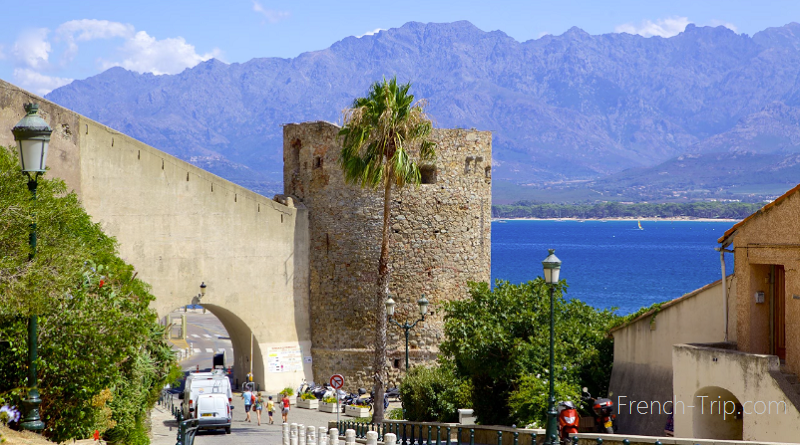
Calvi has long been a sought-after destination, with its appeal historically rooted in its strategic significance. Calvi main sights inlude the magnificent fortification and beautiful nature surrounding the city. Wandering through the city’s cobbled streets will eventually lead you to the impressive Genoese citadel, which towers over Calvi. A stroll along the high ramparts offers a stunning 360° panoramic view of the entire city. The citadel, perched like a jewel on the water, provides a breathtaking vista of the snow-capped Monte Grossu mountains, their shadows beautifully mirrored in the crystal-clear blue sea below.
Calvi Main Sights
Calvi’s Lower Town
In the lower town, the main artery is boulevard Wilson, the continuation of the RN 197 from place de la Porteuse d’Eau to place du Monument-aux-Morts at the entrance to the citadel. But the busiest artery is undoubtedly rue Clemenceau, pedestrianised during the summer, with restaurants and boutiques open until late at night. When summer comes, the square in front of the church of Sainte-Marie-Majeure on rue Clemenceau, an old baroque basilica, is entirely taken up by the terraces of two restaurants.
The Landry quay, which runs along the Xavier Colonna quay (named after the former mayor of Calvi) to the Salt Tower, is lined with restaurants whose terraces overlook the roadway when summer comes.
Salt Tower (tour du Sel)
This imposing tower, built in 1495, is called Callelu. It is an old watchtower, later used to store salt. Attached to the citadel is a double caponier (corridor) with two floors of superimposed stairs. Modified and renovated several times (1897, 1934, 1940s), the caponier is pierced by a porch that provides a link between the Quai Landry and the commercial port. The ramparts of the fortress and the salt tower were classified as historical monuments in 1992.
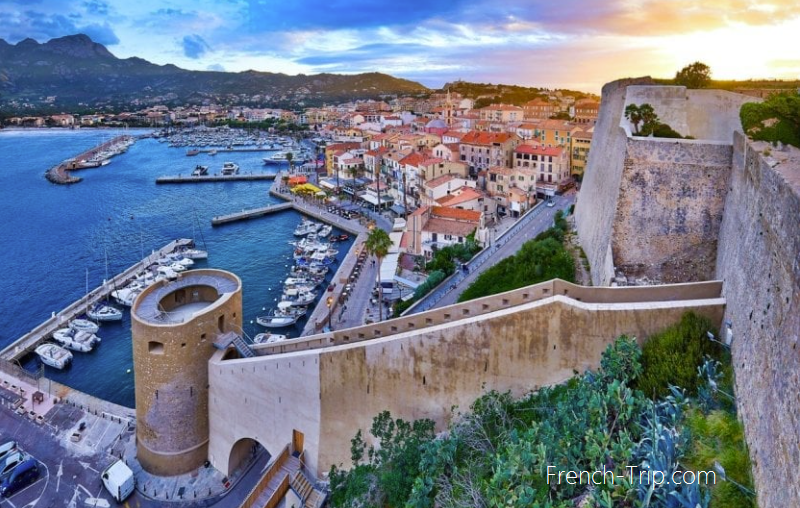
Calvi Citadel and Haute-ville
The symbol of the city, the citadel was built during the Genoese occupation. In 1483, the administration of the island of San Giorgio decided to strengthen the defense of Calvi by building new fortifications, the Castello Vecchio castle being insufficient to ensure the protection of the Presidio. In 1545, in the face of the Franco-Turkish threat, the works were consolidated. The walls will be completed in the eighteenth century.
The ramparts consist of four main bastions (San Giorgio, Sant’Antonio d’Alto, Tegiale and Celle) and a fortification wall. The citadel, its ramparts and the salt tower, which belong to the commune, are listed as historical monuments.
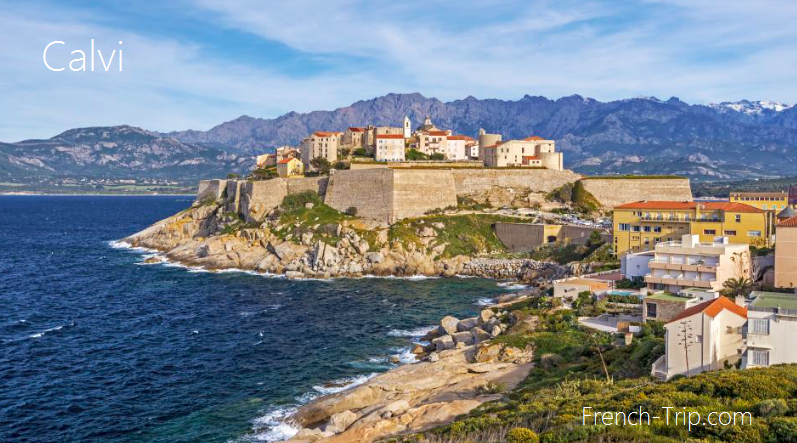
In the citadel itself, it is pleasant to stroll along the picturesque cobbled streets and admire the beautiful view of the bay from the ramparts.
The citadel (or Haute-ville – Upper Town of Calvi) includes beautiful architectural monuments: the Oratory of St. Anthony, Poudrière, the Sampiero barracks (former Palace of the Rulers) and the house of Christopher Columbus.
Cathedral of San Giovanni Battista
Located in the Upper Town in the Genoese fortress, the Cathedral of San Giovanni Battista was the seat of the Bishop of Sagona as early as 1625. Sebastiano Albani, the major bishop, faced with the barbarian threat, fled from Vico, which from 1569 to 1625 served as the seat of the four bishops of Sagona. The bishops had already left for the first time, in 1569, the Cathedral of Sant’Appiano, built along the coast in Savona.
The original church, of which only a few elements remain, dates back to the beginning of the Renaissance. It was probably destroyed in 1555 during the siege of the city by the French, who had allied themselves with the Turks, whose fleets bombarded the citadel. In 1567, lightning, striking the gunpowder magazines of the citadel, destroyed the church. Work on its reconstruction began around 1600; but due to lack of resources the choir was not completed until 1628. The rest of the building was completely completed in 1747.
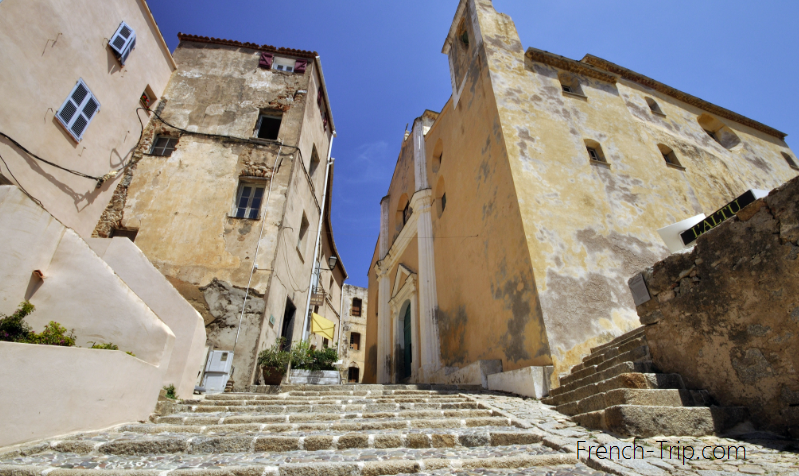
Interior
The loggia and interior decoration of the church are protected, the building is classified as a historical monument.
The cathedral contains beautiful, very old works of art: the baptismal font and the high altar in polychrome marble, the 15th-century triptych in the apse, and the Black Christ of the Miracles (enclosed in a glass niche in the altar), which would have so impressed the Turks in 1555 that they raised the siege of the city. To the left of the altar is a chapel dedicated to Our Lady of the Rosary, decorated with a marble altar. On each side of the altar are two twisted columns of black marble. Our Lady of the Rosary is dressed in her blue dress. On Holy Wednesday, she wears her black dress to take part in all the Holy Week processions in Calvi.
Oratory of Saint Antoine (Oratoire Saint-Antoine)
The Oratory of Saint Antoine is the chapel of the brotherhood of the same name. While the brotherhood of Saint Antoine of the Abbey of Calvi dates back to the mid-fourteenth century, its oratory (called casazza in Corsican) dates back to the early sixteenth century. It has been a historical monument since 1976.
Like most religious buildings, the brotherhood agrees to open its doors to cultural events. Visitors will be able to appreciate three frescoes dating from 1510 and 1513, as well as a triptych representing the Crucifixion and the Annunciation, Christ on the Cross from the end of the 17th century, which is still used for the ceremonies of Holy Week, a statue of the seated Abbot Antoine (15th century) and another of the same saint, dating from 2006, made by the Balanine artist Tony Casalonga.
The Brotherhood of Saint-Antoine-Abbot Calvi is one of the most active and dynamic in Corsica. For more than twenty years, an important work of collecting and restoring the tradition (songs, processions, offices) has been carried out, the brotherhood is actively involved in the dissemination of the liturgy in the Corsican language and is the source of the Corsican translation of the Roman Missal.
Church of Santa Maria Maggiore (Église Sainte-Marie-Majeure)
Built in the Baroque style and painted pink and beige, the church is located in the Lower Town, on rue Clemenceau. In 1774, to meet the needs of the growing population, Calvi built a church dedicated to Saint Mary. Its construction was completed at the end of the nineteenth century. In the list of historical monuments.
Palace of the Governors (palais des Gouverneurs)
Formerly called Castel Nuovo, this twin-towered building in the upper town, built between 1490 and 1492 to replace the Castello Vecchio, served as the residence of the Genoese rulers in the 16th and 17th centuries. Today it is the Sampiero Barracks, home to the officers of the 2nd Foreign Parachute Regiment.

Hôtel Nord-Sud
The Hôtel Nord-Sud is located on the peninsula of Saint-François (Punta San Francescu). This remarkable building was built in 1929 by the architect André Lurçat to house artists’ studios. Later rebuilt, it became a hotel. It is a rectangular two-story building, very typical of the Cubist era.
The hotel, owned by a private individual, is listed as a historical monument. The beautiful hotel garden is also included.

La Pinède
This is the famous beach of Calvi, which is served in summer by a small train from Trinighello. It takes its name from the maritime pine forest to the east of the town, which runs along the beach, from Calvi to the mouth of the Figarella. Since 2011, a wooden walkway has been installed along the tracks, at the western end of the pine forest.
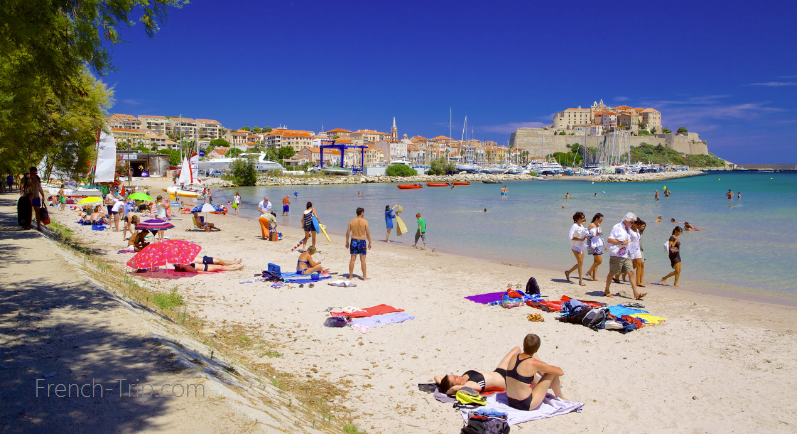
Phare de la Revellata
A 4 km long path will take you to the Revellata headland, where the lighthouse was erected. The Revellata lighthouse is also called the “Lighthouse of the Gulf of Calvi”. Begun in late 1838, the lighthouse was lit in 1844. Its main current characteristics are: 99.50 meters above sea level, two white flashes every 10 seconds and a range of 21 miles.
Archives
Calendar
| M | T | W | T | F | S | S |
|---|---|---|---|---|---|---|
| 1 | 2 | 3 | 4 | 5 | 6 | 7 |
| 8 | 9 | 10 | 11 | 12 | 13 | 14 |
| 15 | 16 | 17 | 18 | 19 | 20 | 21 |
| 22 | 23 | 24 | 25 | 26 | 27 | 28 |
| 29 | 30 | 31 | ||||
